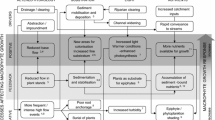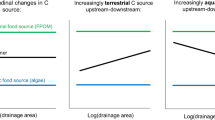Synopsis
We experimentally manipulated fish grazing pressure to determine whether fish herbivory played an important role in the structure of a Costa Rican stream. Non-planktonic plant matter represented a significant percentage (≥ 25%) of the diet of 77% of the 17 fish species in the community. We prevented fish grazing on macrophytes, tree leaves, and periphyton using fish exclusion cages. Fish grazedPanicum sp., used as a generalized aquatic macrophyte, to the stems after 6 days in control areas, and consumed all or much ofFicus insipida andMonstera sp. leaves when placed in the stream after 48 hours. Plants and leaves experimentally protected by cages remained intact. In periphyton studies, fifty percent more ash free dry weight occurred on 25 × 25 cm floor tiles protected from fish grazing by cages than on tiles in roofless controls exposed to fish grazing for 19 days, suggesting a reduction in periphyton biomass. These results demonstrate that fish herbivory affects macrophyte abundance, and impacts the amount of leaf litter in the stream. Fish herbivory may also have an important effect on overall periphyton biomass. Herbivorous fish species generally represent a larger proportion of the total fish community in tropical compared to temperate streams; thus fish grazing is more likely to have an important influence on plant and animal abundances and distributions in tropical streams.
Similar content being viewed by others
References cited
Adebisi, A.A. 1988. Changes in the structural and functional components of the fish community of a seasonal river. Arch. Hydrobiol. 113: 457–463.
Angermeier, P.L. & J.R. Karr. 1983. Fish communities along environmental gradients in a system of tropical streams. Env. Biol. Fish. 9: 117–135.
Burcham, J.K. 1985. Fish communities and environmental characteristics of two lowland streams in Costa Rica. Rev. Biol. Trop. 36: 273–286.
Bussing, W.A. 1987. Pesces de las aguas continentales de Costa Rica. Editorial de la Universidad de Costa Rica, San Jose. 271 pp.
Carpenter, R.C. 1986. Partitioning herbivory and its effects on coral reef algal communities. Ecol. Monogr. 56: 345–363.
Gaines, S.L. & J. Lubchenco. 1982. A unified approach to marine plant-herbivore interactions. II. Biogeography. Ann. Rev. Ecol. Syst. 13: 111–138.
Gatz, A.J. 1979. Community organization in fishes as indicated by morphological features. Ecology 60: 711–718.
Gorman, O.T. & Karr, J.R. 1978. Habitat structure and stream fish communities. Ecology 59: 507–515.
Goulding, M. 1980. The fishes and the forest: explorations in Amazonian natural history. University of California Press, Berkeley. 280 pp.
Goulding, M., M.L. Carvalho & E.G. Ferreira. 1988. Rio Negro, rich life in poor water. SPB Academic Publishing, The Hague. 200 pp.
Grossman, G.D., P.B. Moyle & J.O. Whitaker, Jr. 1982. Stochasticity in structural and functional characteristics of an Indiana stream fish assemblage: a test of community theory. Amer. Nat. 120: 423–454.
Hall, C.A.S. 1972. Migration and metabolism in a temperate stream ecosystem. Ecology 53: 585–604.
Hay, M.E. 1984. Patterns of fish and urchin grazing on Caribbean coral reef: are previous results typical? Ecology 65: 446–454.
Knoppel, H.A. 1970. Food of central Amazonian fishes. Amazonia 2: 257–352.
Kuehne, R.A. 1962. A classification of streams illustrated by fish distributions in an eastern Kentucky creek. Ecology 43: 608–614.
Lewis, S.M. 1986. The role of herbivorous fishes in the organization of a Caribbean reef community. Ecol. Monogr. 56: 183–200.
Lotrich, V.A. 1973. Growth, production and community composition of stream fishes inhabiting first, second, and third-order streams of eastern Kentucky. Ecol. Monogr. 43: 377–397.
Lowe-McConnell, R.H. 1975. Ecology of fishes in tropical freshwaters: their distribution, ecology, and evolution. Longman, London. 337 pp.
Lowe-McConnell, R.H. 1987. Ecological studies in tropical fish communities. Cambridge University Press, London. 382 pp.
Mendelson, J. 1975. Feeding relationships among species ofNotropis (Pisces: Cyprinidae) in a Wisconsin stream. Ecol. Monogr. 45: 199–230.
Menge, B.A. & J. Lubchenco. 1981. Community organization in temperate and tropical rocky intertidal habitats: prey refuges in relation to consumer pressure gradients. Ecol. Monogr. 51: 429–450.
Moyle, P.B. & B. Vondracek. 1985. Persistence and structure of the fish assemblage in a small California stream. Ecology 66: 1–13.
Ogden, J.C. & P.S. Lobel. 1978. The role of herbivorous fish and urchins in coral reef communities. Env. Biol. Fish. 3: 49–63.
Paine, R.T. 1980. Food webs: linkage, interaction strength and community infrastructure. J. Anim. Ecol. 49: 667–685.
Power, M.E. 1981. The grazing ecology of armored catfish (Loricariidae) in a Panamanian stream. Ph.D. Thesis, University of Washington, Seattle. 267 pp.
Power, M.E. 1983. Grazing responses of tropical freshwater fishes to different scales of variation in their food. Env. Biol. Fish. 9: 103–115.
Power, M.E. 1990. Resource enhancement by indirect effects of grazers: armored catfish, algae, and sediment. Ecology 71: 897–904.
Power, M.E., W.J. Matthews & A.J. Stewart. 1985. Grazing minnows, piscivorous bass and stream algae: dynamics of a strong interaction. Ecology 66: 1448–1456.
Pringle, C.M., F.J. Triska & G. Browder. 1990. Spatial variation in basic chemistry of streams draining a volcanic landscape on Costa Rica's Caribbean slope. Hydrobiologia 206: 73–85.
Randall, J.E. 1961. Overgrazing of algae by herbivorous marine fishes. Ecology 42: 812.
Ross, S.T., W.J. Matthews & A.A. Echelle. 1985. Persistence of stream fish assemblages: effects of environmental change. Amer. Nat. 126: 24–40.
Schlosser, I.J. 1982. Fish community structure and function along two habitat gradients in a headwater stream. Ecol. Monogr. 52: 395–414.
Sheldon, A.L. 1968. Species diversity and longitudinal succession in stream fishes. Ecology 49: 193–198.
Small, J.W. 1975. Energy dynamics of benthic fishes in a small Kentucky stream. Ecology 56: 827–840.
Stout, J. & J. Vandermeer. 1975. Comparison of species richness for stream-inhabiting insects in tropical and mid-latitude streams. Amer. Nat. 109: 263–280.
Stout, R.J. 1989. Effects of condensed tannins on leaf processing in mid-latitude and tropical streams: a theoretical approach. Can. J. Fish. Aquat. Sci. 46: 1097–1106.
Welcomme, R.C. 1969. The biology and ecology of fishes of a small tropical stream. J. Zool. (Lond.) 158: 485–529.
Wikramanayake, E.D. & P.B. Moyle. 1989. Ecological structure of tropical fish assemblages in wet-zone streams of SriLanka. J. Zool. (Lond.) 218: 503–526.
Winemiller, K.O. 1983. An introduction to the freshwater fish communities of Corcovado National Park, Costa Rica. Brenesia 21: 47–66.
Zaret, T.M. & A.S. Rand. 1971. Competition in tropical stream fishes: support for the competitive exclusion principle. Ecology 52: 336–342.
Author information
Authors and Affiliations
Rights and permissions
About this article
Cite this article
Wootton, J.T., Oemke, M.P. Latitudinal differences in fish community trophic structure, and the role of fish herbivory in a Costa Rican stream. Environ Biol Fish 35, 311–319 (1992). https://doi.org/10.1007/BF00001899
Received:
Accepted:
Issue Date:
DOI: https://doi.org/10.1007/BF00001899




